Thanks to the decisive and effective measures taken, China has brought the epidemic under control, life has returned to normal and the economy is running normally. However, The epidemic is still going on around the world, the prevention and control measures needs normalization. The design and the operation countermeasures of air-conditioning system in post-epidemic period in China have evoked people’s reflection, so the below discussion around different views and measures will be conducive to the normalization for epidemic prevention in the future.
In view of the environmental control of epidemic prevention and control is different from that of the comfortable air conditioners in the non-medical civil buildings, this article does not elaborate the countermeasures to air-conditioning system in post-epidemic period systematically, but to put forward some concerns around the purpose of the countermeasures, as well as the prevention and control objectives of air conditioning system in the post-epidemic period for your reference.
- The proper positioning to the spread of novel coronavirus
The Diagnosis and Treatment of Novel Coronavirus Pneumonia (trial version 8), issued on August 19, 2020, clearly indicates that the novel coronavirus is mainly spread by respiratory droplets and close contact, as well as contact with the virus contaminated item. Long-term exposure in a relatively closed environment with high concentrations of aerosols may also lead to aerosol transmission. “Owing to the novel coronavirus can be isolated from feces and urine, attention should be paid to prevent it from polluting the environment and lead to contact transmission or aerosol transmission.” which helps us to identify the transmission route of COVID-19 correctly. It’s also confirmed by a large number of infection cases during the epidemic. Wearing masks, keeping social distance and hand washing have been recognized as the most effective measures to prevent and control the epidemic.
Normally, if the virus has good air transmission and diffusion, it would be dispersed continuously under the action of airflow, and be diluted at the same time, then the virus concentration will keep decreasing, as a result, only a small dose of bacteria can be transmitted by air. In addition, the dispersed particles carried with bacteria floating in the air, its vitality would be weaken quickly due to the exposure to the heat, humidity and UV light, unless it has enormous vitality(or can survive in the air for a long time ). No evidence has been found that the COVID-19 has the above two characteristics so far. It can only be said that the COVID-19 has a small chance to be transmitted by air to a limited extent, the possibility to be infected through air is very small. The WHO still believes that SARS-CoV-2 aerosol may be spread in the environment where is airless or closed, but it’s not the main way, although an open letter signed by 239 scholars from 32 countries on July 6 was published in the journal of clinical infectious disease (Oxford University Journal).
Since the infective dose in the air is not enough to transmit, and the droplets can not float for a long time to spread over a long distance, then several super transmission events in the epidemic mentioned on the open letter are confusing. Therefore, we propose a hypothesis of aerosol cloud transmission. Aerosol cloud is a vapor-liquid two-phase flow, which is invisible by eyes.
The state of aerosol cloud can make droplets containing virus particles float, which will be drifting by airflow. The route and direction of its transmission are very clear.
Aerosol cloud can gather the virus particles, hard to diffuse and transmit, with longer survival time, so it’s easy to accumulate a large number of virus locally and maintain an infection dose for a long time over a long distance. It’s considered that the formation of aerosol cloud is related to the factors like closed indoor environment, poor ventilation, high personnel density, high humidity(Fig.1), and the droplets size, etc. Then the hypothesis of aerosol cloud can well explain these super transmission events. Similar hypotheses can also be found in foreign documents(Fig 3.), although the definitions and explanations differ. Environmental factors such as temperature, humidity and pollution can affect the virus survival ability for COVID-19, by damaging its protein in the surface and its lipid membrane. The current theory suggests that its stability will be enhanced at higher humidity (≥80%)(Fig.1).
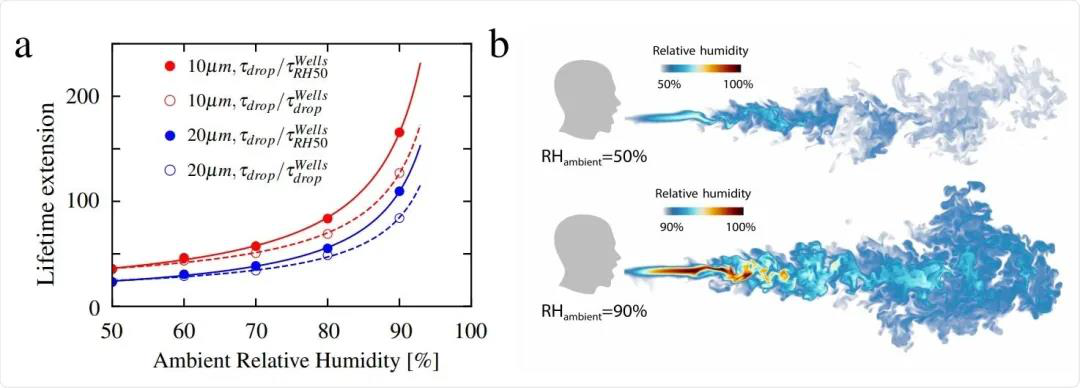
Fig.1 The relation between the span life of virus droplets & the particle diameter and relative humidity.
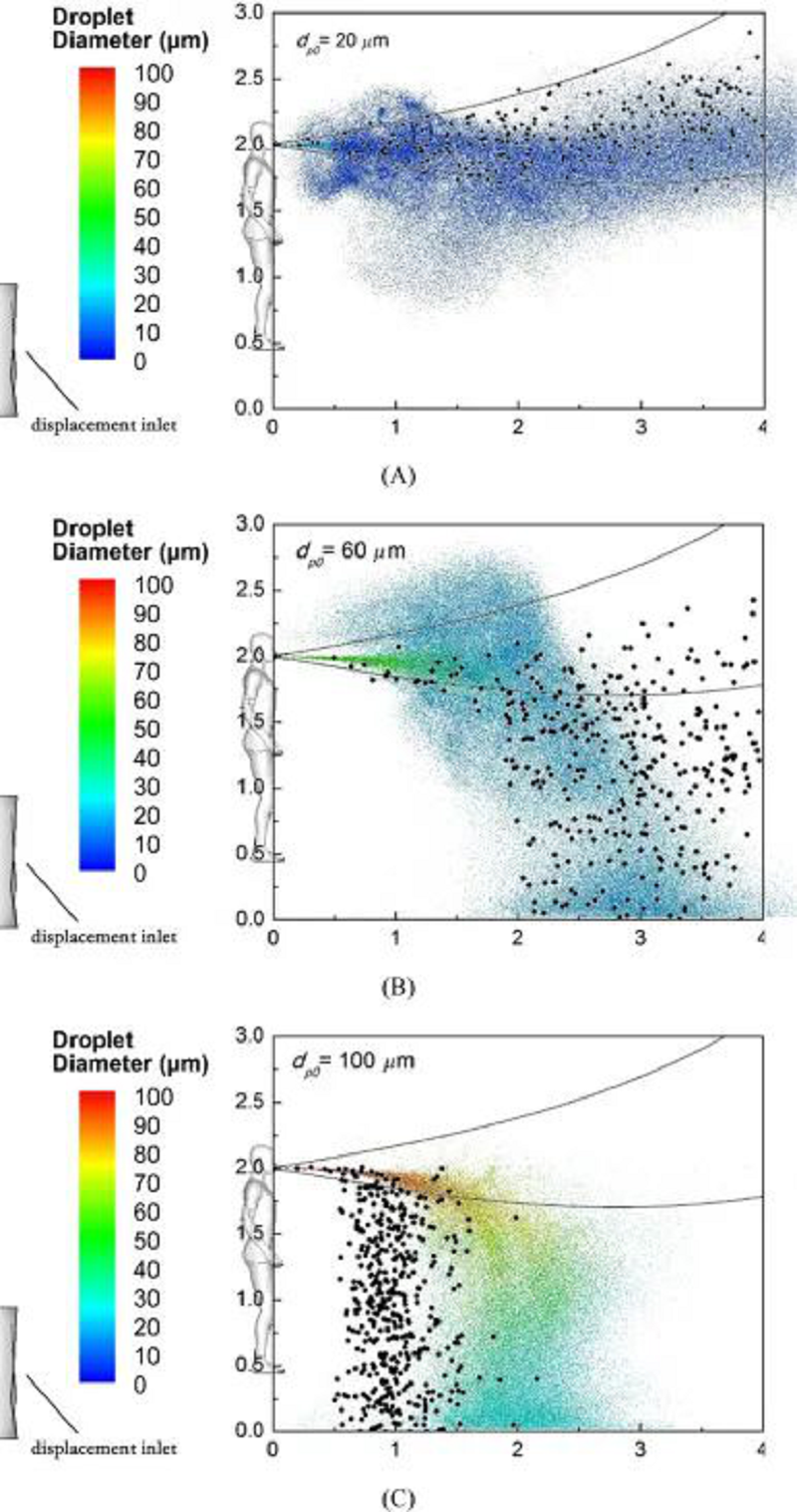
Fig.2 The droplets diameters and its transmission range
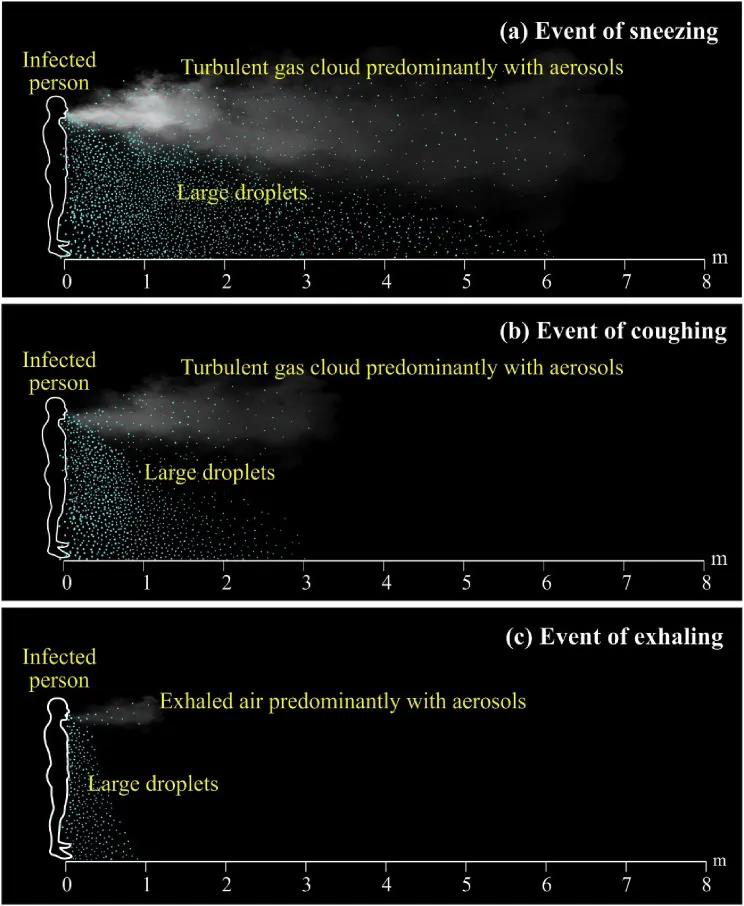
Fig. 3 Sneezing, coughing, exhaling cloud and their transmission distance
2.Countermeasures of air-conditioning system in post-epidemic period
Due to the prevention and control method of pathogens as well as the indoor environmental control requirements and measures in epidemic are different from that of the comfortable air conditioners, so the control method of pathogens can not be understood based on logical reasoning and common sense.
2.1 Focus on the control of aerosol cloud transmission
The control of the spread of COVID-19 in indoor air is not so much as the control of the transmission of aerosol cloud.
The results show that the aerosol cloud has good air current following performance, narrow transmission route and clear direction.
Unlike air transmission, which can transmit widely and pervade in the whole space. Aerosol cloud drifts with the air to nearby the susceptible people’s respiratory organs(Fig.4), which could be inhaled and cause infection, even if it’s kept in a safe social distance. The uncertainty of aerosol cloud transmission disclosed the randomness of getting infected, which challenges our traditional theory in ventilation or prevention and control of infection, such as safe social distance, personal protection, exposure time, risk or probability of infection.
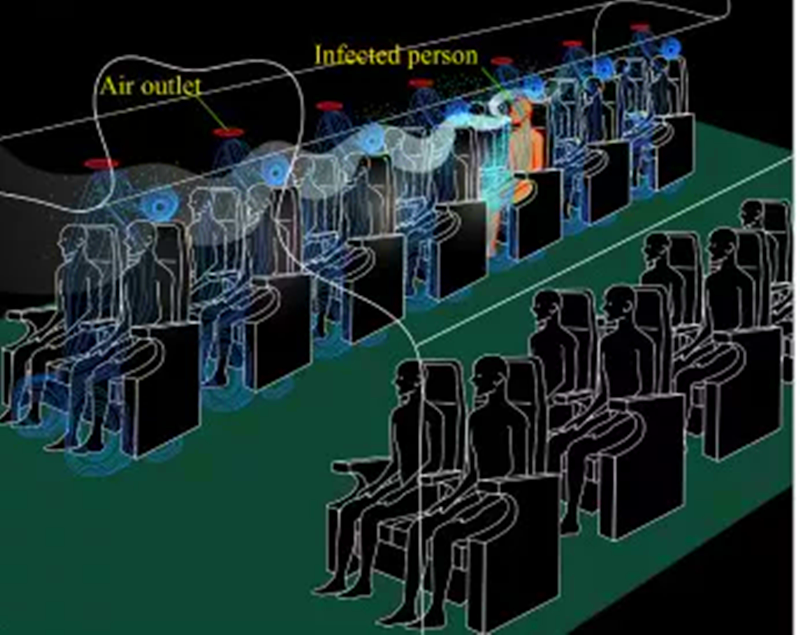
Fig. 4 Aerosol cloud transmission simulation
From the perspective of controlling the transmission of aerosol cloud, there are three ways:
1) Avoiding the generation of aerosol cloud is the most fundamental way, reducing its occurrence( such as wearing masks, controlling personnel density, settling down the droplets quickly by indoor airflow) and maintaining a good indoor ventilation(diluting indoor pollution and avoiding indoor humidity accumulation).
2) Once aerosol cloud is formed, the uncertainty of transmission and the randomness of infection seem to be beyond control. In fact, the simplest way to block the aerosol cloud transmission is to avoid horizontal airflow in indoor, and force it to settle down quickly then discharged from the lower exhaust(return) air outlet under the action of ventilation.
3) The simplest way to eliminate the transmission of aerosol cloud is to disperse the aerosol cloud by external force, the ventilation airflow will continuously disturb or disperse the aerosol cloud, as long as the infectious particles was decentralized and the concentration drops, then it’s not transmissible. Of course, reducing the indoor humidity level to 40%-50% is also a control method, but with large energy consumption.
2.2 Focus on the prevention and control of pathogens
The idea to prevent and control the pathogens during the epidemic is somewhat like the environmental control of pharmaceutical and medical treatment. But it varies from the biological cleaning technology, it is a measure to prevent coronavirus in comfortable air-conditioning service area. We first draw lessons from pharmaceutical and medical control concepts to explain the difference between that and the comfortable air conditioners.
| Air conditioning control method | Pathogens control method | |
| Control method | Parameters control(temperature/ humidity/ pollutants concentration) | Risks control(decrease the pollution/ infection risks) |
| Control points | Whole chamber dilution, focus on the average concentration of the whole room | Key point control(aim at infection route, such as respiratory tract) |
| Airflow distribution | Multiple airflow distributions are allowed. | Supply air from the upside and return air to downside, the bacteria settled and discharged. |
| Exposure time | No request | Minimize exposure time |
| Control | Value control(control accuracy of temp.&humidity) | Magnitude control(infection dose, not a number difference) |
| Adjustment&control | Lag adjustment control(adjustment after detecting the temp.&humidity deviation) | Limitation setting in advance(pre-regulatiuon, such as warning limit, deviation rectification limit and action limit for pharmaceuticals) |
| Fresh air | Fresh air carries most of the heat, humidity and dust, normally adopts the minimum fresh air volume, variable fresh air volume can be used during season transitions from the perspective of energy saving. | Fresh air doesn’t contain pathogens, it’s clean and be conducive to epidemic control, the more fresh air brings in the better. The constant pressure difference is expected to change the fresh air volume, and the indoor and outdoor pressure different remain unchanged. |
| Filtration | Attach importance to fresh air filtration | Pay more attention to the filtration efficiency on the supply air |
| Rectification time for deviation | No request | Attach importance to the self-purification time of dynamic pollution( deviation rectification time) |
| Supply air | Allow variable air volume, ventilation on demand and intermittent ventilation | Adopts rated air volume generally |
| Configure device | General requirements | High redundancy |
| Pressure difference control | General requirements | Control the orderly pressure gradient between different regions |
| Personal requirements | No request | Attach importance to personal protection and enhance immunity |
Fig.1 Differences between the ideas of prevention and control of pathogens and that of ventilating air conditioners.
During the post-epidemic period, three effective prevention and control measures which are wearing masks, keeping social distance and hand washing may no longer be enforced. But controlling the personnel density still needs to be considered. The countermeasure of air conditioning system in post-epidemic period is to prevent coronavirus. The differences of control method refer to table 1. Except the speculation to the prevention countermeasures of air-conditioning system based on logical reasoning or common sense, what concerns we should pay attention to? Some countermeasures can be integrated into the comfortable air-conditioning system, but some may only be used as a backup scheme. Here are some examples:
1) Overall control or key point control
People who engage in air conditioning are used to consider things from the overall situation, such as controlling the parameters of temperature, humidity, and carbon dioxide concentration for the whole space. People who engage in infection control focus on the details and key point, cutting off the route of infection according to the characteristics of the source of infection. Even the layout details of the supply and return air are worth attention. Countless cases have shown that details determine the success of failure of infection control. Details are monsters.
2) Whole chamber dilution or in situ sedimentation
The biggest pollutant of comfortable air conditioners is CO2, people are everywhere in the room, everyone can produce CO2, it is a large area source. Indoor bacteria in general places are exhaled by individual patients, and spread in a short range, it is a point source. Therefore, the control measures can not dilute the whole room with fresh air to control the point infection as the control of CO2, it also can not control the fresh air volume by CO2 sensor. The droplets exhaled by coronavirus patients can directly infect the adjacent, and do not wait for being diluted. Once the pathogen exhaled, it should be settled down on situ quickly to prevent transmission. In situ settlement is the most effective way to reduce exposure. Controlling the point infection by generating multiple times of indoor air volume for dilution not only causes high energy consumption, but also has poor effect.
3) Sterilization or filtration
We all know that the fresh air does not carry the pathogens, and the main purpose of fresh air filtration is dust removal. If pathogens do exist in the room, the return air filter should be able to prevent the pathogens from entering the system. However, the resistance of HEPA filter is quite high, which is difficult or unfeasible to be used in civil buildings. Due to the limited indoor space, the exhaled droplets can not be evaporated into liquid core in small particle size within a short time, and the return air filtration is mainly to remove the droplets in large particles size. Our control target is to prevent the pathogens accumulated in space, so the sterilization efficiency and resistance of the filter should be taken into account when selecting the return air filters.
Article 7.1.11 of GB 51039-2014 code for design of buildings of general hospital indicates:
The return air outlet of central air-conditioning system and fan coil unit must be equipped with filtration equipment with initial resistance under 50Pa, the first passing rate of microorganism under 10%, and the passing rate of particulate weighting at one time shall not be greater than 5%.
This is the same reason why ASHRAE recommended MERV13 as return air filter. For the aerosol cloud, filters can not only filter out some particles in the air, but also disperse the aerosol cloud, making it unable to be existed in the systems.
4) Preventive centralized air-conditioning system or preventive decentralized air conditioning system
According to our common sense, the central air-conditioning system is serving multiple rooms, once the bacteria appeared in one room, the rest would be contaminated. At the beginning of the epidemic, centralized air-conditioning system was the key prevention target, while decentralized air conditioning system was not.
Once an infected individual appears in public places, the gas he exhaled will be suck into the air-conditioning system, but the infective dose in the air supply must be decreased after the process of high-speed running fan, multiple filters, heat and humidity treatment components and the mixed dilution of fresh air. Even if there are aerosol clouds indoor, with the central ventilation and air conditioning system serving multiple rooms, it’s unlikely to cause cross infection. There is no large-scale infection caused by centralized air-conditioning so far. However, the decentralized air conditioning such as air split conditioning, fan coil unit, VRV used in restaurants, bars, buses, entertainment places, their airflow pattern will cause horizontal airflow in the room, pushing the aerosol cloud to drift around(Fig.4).
There are some aggregation infection events occurred from time to time in some places using decentralized air-conditioning during the epidemic, which is also a typical place aerosol cloud spread.
5) Airflow uniform distribution or containment
The air conditioning system emphasizes the uniform distribution of temperature and humidity parameters. Theoretically speaking, the outdoor fresh air keep mixing and diluting with the indoor air, the airflow is distributing evenly, so the virus concentration will keep dropping, but analyzing the details of the distribution process from another perspective, it may be help the pathogens to spread objectively. Therefore, it’s the direction of airflow distribution matters, that is why the purifying space in medical, pharmaceutical, electronic field lay stress on the airflow pattern, which is supplied from upside and returned to downside. It makes full use of the containment role of airflow, making the spot pollution settle as soon as possible, and preventing it from drifting and diffusing, greatly reduce the exposure time. Airflow containment is far more important than uniform distribution. Centralized air-conditioning system can easily realize the airflow pattern be supplied from upside and returned to downside, while decentralized air-conditioning units, which integrates air handling and distribution, is difficult to achieve.
6) Air supply prevention or leakage prevention
Once the indoor air has been polluted, and air-conditioners supply the polluted air to indoor triggered a second air pollution called indirect pollution.
From our common sense, indoor bacteria be supplied by the air-conditioning system is the most terrible thing. Not to mention that the virus can not spread in the central air-conditioning system, even if it can, as long as there is an effective air filter at the air supply outlet or return air outlet, it’s difficult to output the virus. From the perspective of purification engineering, there are few leakage pollution incidents caused by filters and its installation in the current construction and acceptance system. However, the blind increase of fresh air volume without considering the pressure difference control will make the orderly gradient pressure out of control in the area, and the indoor air containing pollution(virus) will leak out directly, causing pollution(infection) incidents frequently. This kind of pollution caused by indoor pollution leakage is called direct pollution, which is even more terrible, the disorderly airflow leakage makes the infection location is hard to predict. That is why the standards or norms for hospital construction at home or abroad do not require high level filters for air supply terminal in key departments, but emphasize the regional orderly gradient differential pressure control .
7) Intermittent operation or continuous operation
Afraid of virus transmit in the air-conditioning system, the intermittent operation of air-conditioning system is often required. That is, the air conditioner will be shut done after running for a period of time, and then natural ventilation or mechanical ventilation will be operation. 2-3 times a day for at least 30 minutes is required. We all know a large number of fresh air brought in will damage the indoor comfortable environment, but what we didn’t know is that the comfortable environment created by air conditioners can also be regarded as an anti-epidemic measure. The going of the epidemic shows that the COVID-19 still maintains a strong infectivity no matter at low or high temperature. While the virus activity reaches the bottom level at room temperature of 22-25℃ and relative humidity of 50%-60%(Fig.5).
The direct entry of strong fresh air also destroys the balance of pressure difference between different spaces, resulting in the disorderly running of leakage airflow.
Therefore, as long as the air-conditioning system is in compliance, the air-conditioning system is not only required continuous operation, but also start up in advance and delay shutdown. Stable and controlled environment is the real demand for the normalization of epidemic prevention and control.
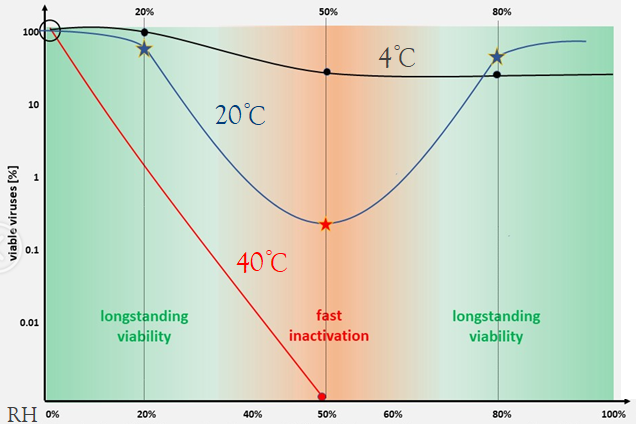
Fig. 5 Survival rate of novel coronavirus & temperature and humidity
8) Lag adjustment or limit prevention
The air-conditioning space control is achieved by the temperature and humidity sensor, which would be adjusted by the system after the sensor detects the temperature or humidity deviation, such process called the lag adjustment.
Relatively speaking, the level of temperature and humidity is very high, the indoor enclosure structure and equipment also have thermal capacity, so to change the indoor temperature of 1℃ requires larger energy or won’t fluctuate greatly.
Even if the temperature and humidity of the comfortable air conditioners have positive and negative deviation control requirements, the adjustment time is generally not the concern. This feature is also the basis for comfortable air conditioners to adopt variable air volume regulation.
Relatively speaking, the level of dust concentration is very small, with a little inattentive, the deviation of particles would be a dozen or even over hundred.
Once the concentration of bacteria and dust exceeds the standard, problems may occur. The parameters must be set under limit before the bacteria and dust were detected excessive.
Intervention shall be made if it gets to the deterrent line. The time from we rectify the deviation of excessive bacteria and dust concentration to the setting state is called dynamic pollution self-purification. This is an important parameter for controlling a controlled environment. But of course, it is related to the control requirements for the processing risk level.
9) Window ventilation or indoor temperature keeping
Window ventilation may be the most economical and effective prevention and control method, but it has little effect on large space. COVID-19 is a self-limited disease, there is no special cure. Immunity is the best doctor and the best medical treatment. No matter in winter or summer, it is necessary to maintain a suitable room temperature. Of course, it can be not that accurate in order to bring more fresh air. It can be controlled within 16℃ to 28℃,as long as it does no harm to your immunity, as improving self-immunity during the epidemic is beyond everything. At some point, Keeping a stable room temperature is more important than opening windows for ventilation.
With regard to the aerosol cloud, the variable airflow direction sometimes may become the driving force for aerosol cloud spread.
10) Transmission cut off or prevention and control measure
What are the purpose of air-conditioning system taking countermeasures in the post-epidemic period? Dealing with COVID-19 patients indoor? or to cut off the spread of the COVID-19?
In the post-epidemic period, the countermeasures of air-conditioning system are prevention and control measures, which may avoid or reduce the occurrence of cross infection if individual case appears. Engineering measures can be taken to prevent its colonization, reproduction and transmission, the virus can only be brought in by patients but not be introduced from the outdoor air , or like the mold and bacteria which is everywhere in the natural environment.
Even if the air conditioning system has strong preventive measures, once a coronavirus case or suspected patient is confirmed, the site must be shut down and the air conditioners must be turned off immediately, timely report to the local health and epidemic prevention agency for emergency treatment, and thorough cleaning and disinfection.
Using excessive prevention and control measures that consume energy and money is of little use. In short, what are the objectives of the air-conditioning system in the post-epidemic period? What are the control target of bacteria? If the prevention and control of coronavirus is still the target, wearing masks, keeping social distance and hand washing are the premise. These actions are better than any other powerful measures of air-conditioning system if everyone including COVID-19 patients can do so.
If the control target is to prevent and control the bacteria cross infection in a general sense, then GB 51039-2014 ” code for design of general hospital building” has been taken into the account when preparation, that is , in public area, we can adopt three measures which are common control measure used in general medical environment, they are reasonable ventilation, supply air from upside and return air to downside and proper filtration in return air outlet. These measures have been proved to be economical, low energy consumption, effective and mature by practice over the past years. If condition permits, it’s feasible to use air conditioners with constant pressure difference and variable fresh air volume.
3.Conclusion
This article suggested that respiratory droplets and close contact are the main transmission route of COVID-19. It’s possible to get infected by aerosol if exposed in a closed environment with high concentration of aerosols for a long time, which has been proved by nearly 30 million cases of infection in the epidemic. Wearing masks, keeping social distance and hand washing have been recognized as the most effective measures to prevent and control the epidemic.
The frequent aggregation infection occurred in a limited space is very likely caused by aerosol cloud.
The existing unidentified super transmission cases can be reasonably explained by the theory of aerosol cloud transmission. It is not difficult to simulate the transmission of aerosol cloud by CFD, but it is futile without the support of a large number of epidemiological survey. Although the uncertainty and randomness of aerosol cloud transmission challenge the traditional theories and countermeasures in infection prevention and control, but it’s not difficult to control the aerosol cloud transmission.
The air-conditioning system in the post-epidemic period should first determined the purpose of countermeasures and control objectives. It should avoid to speculate the countermeasures and control objectives from logic reasoning and common sense.
Non-medical air-conditioning system in the post-epidemic period can adopt three measures which are commonly used in the control of general medical environment, namely reasonable ventilation, airflow distribution and proper filtration of return air. These measures are low energy consumption, low cost and have strong feasibility. Excessive prevention and control measures are unnecessary. In one word, the countermeasures of air-conditioning system in the post-epidemic period should be compliant, appropriate and reasonable.
Posted by Shen Jinming and Liu Yanmin on HVAC
Post time: Oct-14-2020








